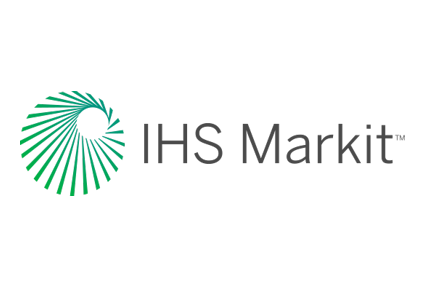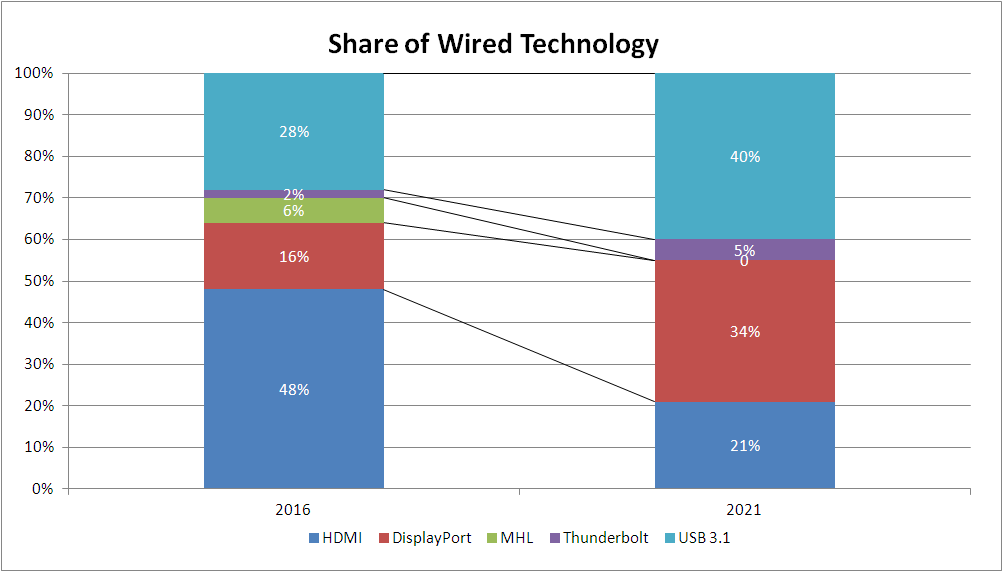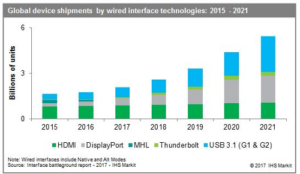 Wireless connectivity could be the future but when it comes to transfer of high-data, ultra-high definition video and secured transmission there is no better match to bandwidth and features provided by the wired interface technologies according to Norman Akhtar, analyst, home appliances at IHS Markit. These wired interface technologies include both the wired audio/video interface and the wired data interface.
Wireless connectivity could be the future but when it comes to transfer of high-data, ultra-high definition video and secured transmission there is no better match to bandwidth and features provided by the wired interface technologies according to Norman Akhtar, analyst, home appliances at IHS Markit. These wired interface technologies include both the wired audio/video interface and the wired data interface.
HDMI, DisplayPort and the Mobile High-Definition Link (MHL) are the most popular wired video interface technologies in the consumer segment. Whereas high-bandwidth data or performance interface includes the Thunderbolt and the USB 3.1, the demand for underlying devices partly drives the market for these wired interfaces.
According to IHS Markit the number of devices that will have at least one external wired interface port is forecast to grow at a compound annual growth rate (CAGR) of around 24%, from 1.7 billion devices in 2016 to 5.2 billion devices in 2021. The computing (PC) segment – which includes desktop PCs, mobile PCs, Table PCs, LCD PC monitors, business projectors, USB flash drives and adapters – and the consumer electronics (CE) segment – which includes set-top boxes and TVs among others – contributed roughly 91% of the total wired interface market in 2016, while the remaining 9% is distributed between the wireless segment and automobiles.
HDMI has the largest installed base of all related wired video interface technologies and is the most popular interface in digital and smart televisions, HD and UHD set-top boxes, Blu-ray players/recorders. The unit shipments of CE devices adopting HDMI technology registered an annual growth of 5.7% in 2016 compared to 2015. This directly related to the growth in these device markets during the same period. IHS Markit forecasts that adoption of HDMI technology in the CE segment will grow at five-year annual growth rate of 4.7% from 2016 – 2021.
DisplayPort is becoming a more popular solution across the PC and the mobile phone segment. Moreover, the release of alternate mode (Alt Mode) specification by VESA in 2014 gave a leading edge to this interface technology in the form of USB Type-C DisplayPort Alt-mode. The combined DisplayPort market, which includes native and the alternate mode protocol, is expected to dominate the wired video interface market for both the computing (PC) and wireless (WL) segments by 2021, taking the lead over HDMI.
Kithany commented
“A USB Type-C port enabled with the DisplayPort feature has the capability to deliver high-speed data and video and an unprecedented amount of power over a single cable is a breakthrough achievement, which is predicted to improve convenience while considerably reducing waste and clutter.”
Before being in the news in 2016, MHL was the only wired interface supported by the mobile phones. It was centered around transmitting video from portable devices like smartphones and media tablets to TVs, projectors or to LCD monitors; but with the introduction of the USB Type-C connector with different video Alt Modes (HDMI & DisplayPort), the adoption of MHL among the consumer devices crashed. Currently, only a few TV-sets provide MHL-enabled HDMI ports; but it will not be long before these TV-sets gets overtaken by either HDMI or DisplayPort alt modes related to USB Type-C. Overall, the market for devices adopting MHL is anticipated to disappear rapidly through 2019.
 DisplayPort will overtake HDMI according to the IHS forecast. Image:Meko
DisplayPort will overtake HDMI according to the IHS forecast. Image:Meko
Thunderbolt seems to be settling in as a small, niche interface technology.
Thunderbolt went through major specification upgrade in June 2015 when Intel unveiled Thunderbolt 3 which doubled data rate from 20Gbps to 40Gbps; increased power to 100W charging in either directions; and added Alt Mode capability over USB Type-C connector. The Alt Mode was the most significant feature of Thunderbolt announced by Intel. It offers the opportunity to take Thunderbolt 3 from a niche interface to a more widely adopted one by offering high bandwidth and high power.
“Overall, though Thunderbolt offers great capability, its impact in the interface world is uncertain. It offers greater bandwidth than USB and HDMI and greater versatility than DisplayPort ” added Akhtar.
The total market for Thunderbolt-enabled devices in terms of unit shipments is projected grow at a CAGR of around 51% from 2016 to 2021, basically driven by Thunderbolt Alt-mode specifications and Intel’s plan to bake Thunderbolt technology into its core processors.
USB 3.1 is a data interface announced by USB Implementer Forum (USB-IF) in July 2013, which further gained approval from Engineering Change Notices (ECNs) in February 2017. The USB 3.1 specification has two generations; USB 3.1 Gen 1, which primarily absorbed the specification of USB 3.0. The terms, USB 3.1 Gen 1 and USB 3.0, are nowadays used synonymously. USB 3.1 Gen 1 specification has a maximum data transfer rate of 5 gigabits per second (Gbps). The second generation, USB 3.1 Gen 2, which was released simultaneously, is called USB SuperSpeed+ or SuperSpeed USB 10Gbps. USB 3.1 Gen 2 interface allows a maximum data transfer rate of 10Gbps. This high data transfer rate benefits devices such as Solid State Drives (SSD) and High Definition (HD) displays. USB 3.1 Gen 1 has had a higher adoption rate in the computing and wireless category. However, notebooks, desktops PCs, docking stations, and USB flash drives started adopting USB SuperSpeed+ (Gen 2) from 2016 onwards.
“The growth in adoption in the USB Type C specification would be one of the key drivers to the growth in the overall USB 3.1 marke,” said Kithany.
Analyst Comment
We looked at the numbers and were surprised to see the dominance of PCs and computing until we realised that USB before USB 3.0, which is ubiquitous in smartphones, is not included in the analysis. We’re not sure why, but that would surely be the dominant connection, if included.
I have long been a fan of DisplayPort and it’s good to see that the momentum continues with the wide adoption of the USB Type C Alt Mode. HDMI really missed a trick in being very late to develop and introduce an Alt-mode. Although such a mode exists, it seems that it is not proving popular. (BR)

